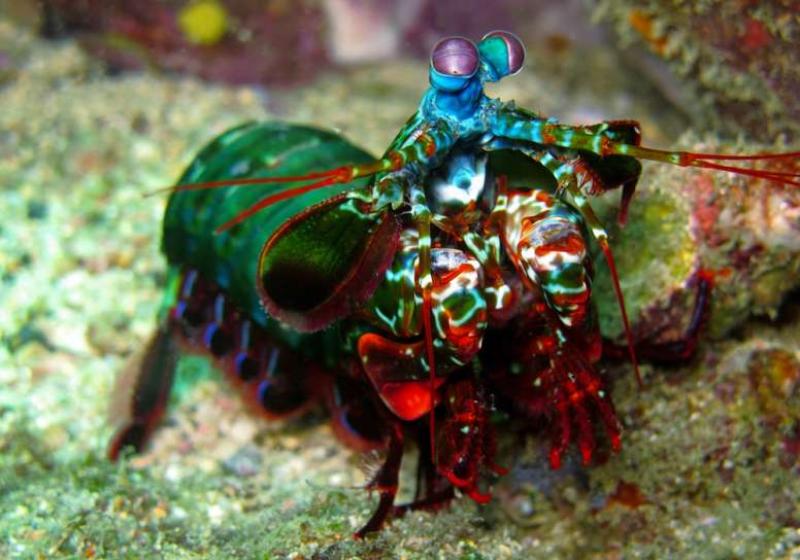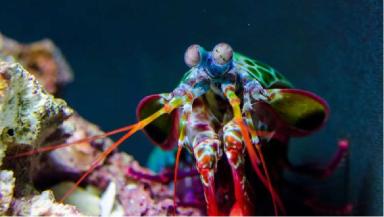14 Incredible Mantis Shrimp Facts - Fact Animal
By: Fact Animal


We were talking about the intelligence of different animals on another seed and I dd not want to derail it to prove just how intelligent,
devious and down right evil ( destructive ) some animals can be when they find themselves captive.
Many strange worm and shrimp species find themselves captured and transported among large pieces of coral or coral rubble known as
"live rock" from India or the Polynesians. Live rock in transport is never allowed to be submerged or dry out, yet worms and shrimp
burrowed deep inside survive months long trips around the world and in pet shop holding bins or tanks.
Consequently, they are unknowingly introduced to people's salt water coral tanks or combo coral and expensive marine exotic fishes tanks.
They can be silent and observing for months, moving only at night when they are assured privacy and
no attention to the small but persistent scraping and digging sounds as they build a series of hiding places and ambush places.
When comfortable they will start chipping away at solid rock and glass, testing their prison cell like any human prisoner on death row
causing clicking sounds to echo through a four story house.
I heard my own personal nemesis three floors away, and s/he always heard me coming and stopped before I could reach the tank.
Eventually I put red nightlights on the night timer and started sleeping in the room next to the tank, just to catch a glimpse of him/her
trying to catch a glimpse of me.

Mantis Shrimp Profile
The Mantis Shrimp (or 'Stomatopod') is a small, aggressive marine Crustacean, that inhabit tropical and subtropical waters of the Indian and Pacific Oceans between Eastern Africa and Hawaii.
They are beautiful and vibrant in colour, but also deadly, able to club prey with the force of a bullet, or spike them with their sharp claws.
They are members of the order Stomatopoda and taxonomy group Crustacea, which are hard-shelled animals, such as crabs, lobsters, crayfish, shrimp, krill and more.
Mantis Shrimp Facts Overview
| Habitat: | Indian & Pacific Oceans |
| Location: | Between Eastern Africa & Hawaii |
| Lifespan: | 3 - 6 years |
| Size: | 10 - 20 cms (4 - 8 Inches) |
| Weight: | 12 - 90 grams |
| Color: | Vibrant multi-coloured - Green, blue, red, orange |
| Diet: | Fish, crabs, worms & shrimp |
| Predators: | Humans, yellowfin tuna, larger fish |
| Top Speed: | 30 body lengths per second |
| No. of Species: | Approx. 450 |
| Conservation Status: | Not endangered |
The mantis shrimp is notorious for their striking force , and have the nickname ' thumb splitter ', due to the painful gashes they can cause if handled without care by humans.
There are around 450 species of mantis shrimp worldwide, and their colours range from shades of brown to bright, green, red and blue. The most infamous species is the Peacock mantis shrimp (also known as harlequin mantis shrimp, painted mantis shrimp, or clown mantis shrimp), and is one of the larger, more colourful mantis shrimps commonly seen.
They typically grow to around 10cms (4 inches) in length, but some have been recorded to be as large as 46cms (18 inches). The mantis shrimp's shell (known as a 'carapace') covers only the rear part of the head and the first for segments of the thorax.
While they are relatively common, they are not particularly well understood species as they are solitary and territorial sea creatures, spending most of their time hiding in rocks and burrowing in the sea bed.
They are most commonly found in U shaped burrows at the base of coral reefs. Depending on the species, they can be active during the day or entirely nocturnal.
Mantis shrimp are a violent predator and their diet depends on the species. They typically eat fish, crabs, clams, snails, worms, shrimp and squid. They can also prey on animals much larger than themselves, due to their significant power.
Mantis shrimp are not considered to be threatened or endangered by the IUCN.
Interesting Mantis Shrimp Facts
1. All mantis shrimp species can be divided into 'spearers' or 'smashers', based on the types of claws they have and tactics they use to kill the prey.
Spearers have spiny appendages with barbed tips, that are used to stab soft-bodied prey, such as different types of worms and fish. Smashers have more developed club-like appendages that are used to blugeon and smash their prey to pieces.

2. Smashers can punch at same velocity as a gunshot from a .22 caliber rifle.
Smasher mantis shrimp have two raptorial appendages (called 'dactyl clubs') on the front of its body that it uses to punch its prey. These fists are spring loaded, able to accelerate from their body at over 50 mph, delivering a force of over 1,500 newtons, enough to smash through crabs and clam shells.
That's 2.5k times the force of the shrimps own weight, if a human could do that they'd be able to punch through steel.
3. Their punch is so fast it results in 'cavitation' bubbles. This is a super heated bubble and small flash of light, which for split seconds also generates temperates of 4,400c (which is nearly as hot as the sun) in the surrounding water.
When the bubbles collapses they cause an intense shockwave which is like a double punch and can stun, dismember or kill prey instantly - even if the mantis shrimp misses the target.
4. They can crack and punch holes in aquarium glass.
While they are highly desired, they require special stronger aquariums. When they encounter an obstacle they wish to move, they often try and punch their way out. They have also been known to attack their own reflection through the glass.
5. Their clubs have a special shock absorbent core which stops them from breaking.
Beneath their hard coated clubs, mantis shrimp have special layers of elastic polysaccharide chitin, which are positioned in a way to act as shock absorbers. This structure is called a bouligand structure, and it keeps small cracks from becoming a full break. Researchers have even studied their cell structure for advanced body armour for combat troops, car frames and aircraft panels. 1
6. They are not actually shrimp. Or Mantis.
The mantis shrimp is not a shrimp, and it's not related to the praying mantis, either. Instead, mantis shrimps are 450 different species belonging to the order Stomatopoda.
7. Mantis shrimps get their name from their appearance. They have a second pair of prey-catching arms that are greatly enlarged, like Mantises.
They are shaped like the large grasping forelimbs of the praying mantis insect, which captures prey.
8. Eyes of mantis shrimp are located on the long stalks that can move independently.
Each eye has 'trinocular vision', which means it can gauge depth and distance on its own by focusing on objects with three separate regions.

9. They are thought to have the most complex eyes in the animal kingdom and have the most complex visual system ever discovered
They can see a special spiralling type of light called circularly polarised light that's not been documented in any other animal. They also have a structure in their eyes that's similar to technology found in DVD players, only much more advanced.
10. The mantis shrimp has 12-16 different colour photoreceptors for colour analysis in their retinas. Three times more than a human.
While they have significantly more colour photoceptors, research suggests they are actually worse at differentiating colour than humans. However, scientists believe this is because their eyes are operating at a different level, functioning more like a satellite. It's believed Mantis shrimp can take all visual information into their brains immediately without having to process it, allowing them tor react instantly to the environment. 2
11. Mantis shrimp can detect cancer cells with their eyes.
Researchers from the University of Queensland believe that the compound eyes of mantis shrimp can detect cancer lesions and the activity of neurons, because they have the ability to detect polarised light that reflects differently from cancerous and healthy tissue - before they appear as visible tumours. It's inspired a group of researchers to build a proof of concept camera sensor, inspired by the mantis shrimps ability. 3
12. The are older than dinosaurs.
Stomatopods began evolving independently from other members of the class Malacostraca nearly 400 million years ago, about 170 million years before dinosaurs. 4

13. Some mantis shrimp species are monogamous, remaining with the same partner for up to 20 years.
They live to together in the same burrow, and both male and female take care of the eggs.
14. Mantis shrimp are eaten in Japanese, Cantonise, Vietnemese, Mediterranean, Phillipino and Hawaiin cuisines.
After cooking, their flesh is closer to that of lobsters tahn shrimp. In Asian culture, they are often deep fried with garlic, and chilli.
Mantis Shrimp Fact-File Summary
Scientific Classification
| Kingdom: | Animalia |
| Phylum: | Euarthropoda |
| Subphylum: | Crustacea |
| Class: | Malacostraca |
| Subclass: | Hoplocarida |
| Order: | Stomatopoda |
Fact Sources & References
- "Bio-inspired impact-resistant composites", via Science Direct.
- "The Mantis Shrimp Sees Like a Satellite", via National Geographic.
- "A Mantis Shrimp Inspires a New Camera for Detecting Cancer", via Smithsonian.com.
- "Circular Polarization Vision in a Stomatopod Crustacean", via Cell.com.

 Article is LOCKED by moderator [Split Personality]
Article is LOCKED by moderator [Split Personality]



I admit it. I loved to hate this SOB.
Now the small octopus I had put every thing else to shame as far as intelligence goes...
No politics please.
... uh, yeah ...
Well, I could hear the mining being done, and i can count the expensive fish that disappeared.
When it ran out of dumb fish, it began eating corals.
It basically took a showcase of color and life and turned it into a desert.
Until it died of old age or it was eaten (unlikely ) by an 18 inch long engineer (convict) Goby,
no judgment, commiseration. I've worked thru having aquatic pets 3 times. a collection of breeding tanks that I finally got tired of devoting weekends to cleaning. a tank for 1 son that featured frogs with expensive appetites for tropical fish. a tank for another son that decided to release his piranhas back into the wild, in colorado ... now the only fish I care about are usually at the end of a line or on a plate in front of me.
Cool!
So get this, my engineer ended up being as thick as a hot dog and 18 inches long
After four or five years s/he would "spontaneously" give birth to hundreds of babies smaller than a grain of rice
in spite of no mate.
When I tried to take pictures without getting flash back from the tank itself, the babies would all disappear into the parent's mouth.
I don't know why but she would guard them for about a week, then I am assuming that she or some of the large damsels ate them
but I suspect it was her because there were never any stragglers or escapees and those fish were expert at hiding.
Mantis shrimps, truly the ultimate badasses of the crustacean community !
Wow, that is amazing.
Very cool beast!
Good photos.
How can you not like a monogamous killer shrimp?